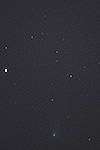
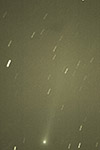 Images by Steve Luzader
Images by Steve LuzaderA little before 4:30 AM on Nov. 2, 2013, I set up the school board's NexSTAR 8SE at Field 7 in the Glendening Recreation Complex to photograph Comet ISON. The telescope is an 8-inch SCT to which I attached an f6.3 focal reducer. The left image shows a 59-second test exposure taken at 4:37 AM to see how well the alt-az mount would image stars. ISON is the greenish glob in the lower center of the image. The tail is difficult to see in this exposure. The right image is the result of stacking 39 15-second exposures taken from 5:35 - 5:51 AM, when the sky was beginning to brighten. These images were stacked and processed using AIP4WIN and Photoshop. The tail is easily seen, although the short exposures reduced color saturation. The length of the star streaks show how much the comet moved during the 16 minutes of exposures. Both images are cropped from the full frame. The camera was my Canon 60Da set for ISO1600.
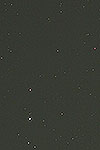 Image by Steve Luzader
Image by Steve LuzaderHere's my first reasonable attempt at an image of Comet C/2012 S1 (ISON). The comet is hard to see--it's the faint greenish glow in the top center third of the image. This is a stack of ten 30-second exposures taken with a Canon 60Da SLR fitted with the 300 mm Rokunar at f6.3. The camera was set for ISO1600. The pictures were taken around 5 AM on October 29 from our observing site at the Parris Glendening Recreation Complex in Frostburg. The bright star in the lower left third of the image is Chi Leo. This image is half of the full camera frame.
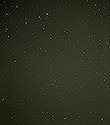
 Image by Steve Luzader
Image by Steve LuzaderHere are pictures of Encke at about 5:30 - 5:45 AM on October 29, 2013 as it cruised into the Virgo Cluster of Galaxies. Clicking on the left thumbnail brings up an image taken with a Jena 135 mm lens at f4. The image is a full-width crop from a stack of ten 30 second exposures at ISO400. The image has been shrunk to fit on the screen and Encke is barely visible (it's circled) and most of the galaxies don't show up. If you want to zoom in and look for galaxies, here is the full image. Clicking on the right thumbnail brings up an image taken with a 300 mm Rokunar lens at f6.3 Encke is easy to see in this full width cropped image. It is the blue-green object between NGC4216 (just to its right) and M99, with M98 above M99. The image is a stack of eleven 30-second exposures at ISO1600.
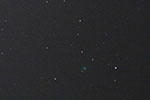 Image by Steve Luzader
Image by Steve LuzaderIn all the hoopla over comets PanSTARRS and ISON, an historically significant comet had been overlooked. In October 2013, Comet ISON and Comet 2P/Encke were located on opposite sides of Leo. Encke is noteworthy because it was the second periodic comet to be identified (after Halley) and it has the shortest period of all known comets (a little over 3 years). This image was taken at 5:30 AM EDT on October 28, 2013, from the Glendening Recreation Complex in Frostburg, using a Canon 60Da SLR fitted with a 300 mm Rokunar lens set at f6.3. The exposure was 30 s at ISO1600. The image here is the lower 1/3 corner of the entire frame. Encke was actually considerably brighter than ISON at the time the photo was taken. It looks like a blue-green blob in the lower center of the image. No distinct tail is visible because at this point in its orbit the tail is pointing towards earth.
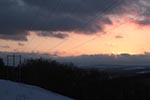
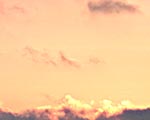

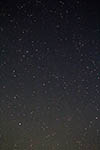 Images by Steve Luzader
Images by Steve LuzaderComet C/2011 L4 PanSTARRS was the first of two comets predicted to be "great comets" in 2013. I went to Big Savage Mountain just west of Frostburg to look for it the first day it was expected to be visible (March 8, 2013). I saw what I thought was a bright jet contrail, but it didn't dissipate and it was setting along with the sun. It was PanSTARRS, which was easily visible to the naked eye once I know where to look. The far left image shows the general scene, and the next image is a crop showing the comet. The photo was taken with a Canon 60Da SLR using a 17 - 50 mm zoom lens at 50 mm. The exposure was 1/1000 s at f10, ISO1600. I expected great things, but PanSTARRS turned out to be quite ordinary. The next two images show PanSTARRS on March 23 (near Alpheratz in Andromeda) and on April 20 when it was located between Shedir and Caph in Cassiopeia. (You have to look carefully to see the comet!) The March photo was taken from Big Savage and the April shot was taken from the Glendening Recreation Complex in Frostburg to celebrate Astronomy Day 2013. Both images were taken with a Canon 60Da using a 135 mm Jena lens set at f5.6. The March 23 exposure was 5 s @ ISO1600; the April 20 exposure was 8 s @ ISO3200.

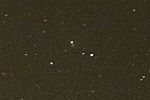 Images by Steve Luzader
Images by Steve LuzaderComet Garradd is still visible in larger telescopes. According to Sky & Telescope, the comet must be quite large because it is relatively bright in spite of being very far away (beyond the orbit of Mars). I have pictures of it below from last August, and on April 15 I got another image. The left-hand picture shows the general star field around 10:50 PM EDT on the 15th. The star at the center of the circle looks slightly elongated because the comet is right beside the star. The right-hand image is cropped from the full frame to show the comet and the star. The pictures were taken with a Canon 40D DSLR equipped with a 135 mm Jena lens at f4, ISO1600. The camera was riding piggyback on an 80 mm refractor, which I guided by hand. (I couldn't see the comet in the small refractor.) The full-frame exposure was 2 minutes, while the exposure of the closeup was 1 minute. I estimate the diameter of the coma was around 200,000 km in August, when the comet was 1.33 AU from earth. In the new image, the comet is 1.83 AU away and the coma appears to be about 93,000 km in diameter. By comparison, the radius of the moon's orbit around the earth is about 385,000 km. So the comet is quite large


 Images by Steve Luzader
Images by Steve LuzaderOn November 8, 2011, asteroid 2005 YU55 passed closer to the earth than the Moon. The asteroid is small, only about 1300 meters (400 feet) in diameter, according to Sky & Telescope magazine, and was only about 11th magnitude. The Sky & Tel finder chart suggested it would be moving very fast, crossing the sky at an angular rate of nearly 10 arcseconds per second. I managed to get images that barely register 11th magnitude stars, and the asteroid is an even fainter blur because its 11th magnitude brightness is spread across several pixels. Clicking on the left thumbnail shows a single negative image of the asteroid approaching a pair of 6th and 7th magnitude stars (SAO107620 and 107611) near the middle of its track across the sky as seen from the US. The middle thumbnail is an animated gif showing the asteroid approaching and passing between the stars during a 10-minute period ending at 9:34 PM, and the right thumbnail is an animated gif showing the asteroid's progress through the stars of Pegasus from 8:59 PM until 9:34 PM. The asteroid itself is not visible in the longer animation, but its location is circled. The gifs are large files, so patience is needed while they load. The individual images were taken with my Canon 40D fitted with a 135 mm Jena lens set at f4 at ISO3200. The camera was riding piggyback on my 8-inch SCT and was under computer control to take a 10-second exposure every 30 seconds. The sky was very bright because of a nearly full moon. The images with the two stars are small crops from the full frame taken by the camera. The bright red streak in one frame near the end of the movies is from a passing airplane.
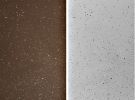 Photo by Steve Luzader
Photo by Steve LuzaderThis pair of images shows Comet Garradd between M71 and the Coathanger asterism (aka Collinder 399 or Brocchi's Cluster) on Aug. 29, 2011. The comet and M71 are barely visible in the color photo, so I made a BW negative image to show them more clearly. We had observed Garradd next to M71 at the Meyersdale, PA, Stars in the Park on Aug. 26 under favorable viewing conditions. On the 29th I was experimenting with a "new" mount (an old Celestron CG-5 I picked up) that wasn't tracking properly, so I wasn't able to take a long exposure that would really show the comet well. I fixed the mount the next day and wanted to get an image of the comet right beside the Coathanger during Sept. 2 - 4, but the clouds didn't cooperate. So I ended up with only these relatively poor images. The Coathanger is in the upper left corner, Garradd is just below the center, and M71 is just right of the bottom center. The exposure was 90 seconds at ISO3200 using a Canon 40 D riding piggyback on a small refractor. A 28 - 135 mm lens was set for 100 mm at f5.6. The image shown here was cropped from the full frame.
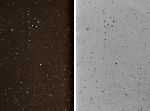 Photo by Steve Luzader
Photo by Steve LuzaderThis pair of images was also taken on Aug. 29, but with the lens set at 135 mm. All other exposure parameters are the same as above. Garradd is in the lower right corner. This image was also cropped from the full frame.
 Photo by Steve Luzader
Photo by Steve LuzaderThese three images show Comet 103P/Hartley 2 as it cruised past the Double Cluster in Perseus on Oct. 7 - 9, 2010. The Oct. 7 image was taken from my back yard in Frostburg, MD; the Oct. 8 image was taken at the Broughton Nature and Wildlife Education Area in Marietta, OH; and the Oct. 9 picture was made during Stars in the Park at Soccer Field 7 in Frostburg's Parris Glendening Recreation Complex. The images were taken with a Canon 40D SLR through a 28 - 135 mm lens set for 135 mm at f5.6. Each exposure was made at ISO 3200 for 1.5 minutes. For the Oct. 7 - 8 images, the camera was piggybacked on an 80 mm refractor on a hand-guided non-motorized equatorial mount. For the Oct. 9 image, the camera was riding on my 8-inch SCT on a Losmandy GM-8. The Oct. 8 image is out of focus because I forgot to turn off the lens's automatic focusing after I carefully focused it manually. But at least you can still see where the comet is (and you can clearly see the colors of the stars!). On Nov. 4, the EPOXI spacecraft flew by Hartley 2. Click here for the story and closeup images of the comet's nucleus.
 Photo by Steve Luzader
Photo by Steve Luzader
Comet Lulin near M44, the Beehive Cluster, on March 4, 2009. This
image was cropped from the full frame. This piggyback picture was
taken with a Canon 40D SLR. The exposure was 2 minutes with the
lens set for a focal length of 135 mm at f/6.3. The ISO setting was 1600.
 Photo by Steve Luzader
Photo by Steve Luzader
Comet Holmes on Nov. 30, 2007. The exposure was 10 minutes on
Kodak ASA 200 film. The camera is piggybacked on the telescope.
The lens used is a 70 - 210 mm zoom set for 210 mm at f/5.6.
The bright star at the bottom left is Mirfak. The
small inset
at the left shows the Oct. 31 image at the same linear scale as the new
image. The coma has increased in diameter by more than 4 times.
The diameter on Oct. 31 was about 375,000 km (about half the
diameter of the Moon's orbit around the earth). By the end of
November, I estimate the diameter to be about 1,600,000 km, slightly
larger than the diameter of the sun! The faint fuzzy object below
and to the right of the comet is the open cluster NGC1245.
 Photo by Steve Luzader
Photo by Steve LuzaderComet Holmes on Nov. 29, 2007. This is a fixed tripod shot of the sky showing Comet Holmes just right of center and the Double Cluster in Perseus above the center of the left side of the image. The exposure was 40 seconds on Kodak ASA 200 film with a 50 mm lens at f/2. Compare this photo with the ones below taken in late October and early November. The comet has grown in size until it is larger than the Double Cluster and has moved to the opposite side of Mirfak.
 Photo by Steve Luzader
Photo by Steve Luzader
Comet 17P/Holmes photographed on October 31, 2007. The exposure was 2.5 minutes
through my 8-inch SCT at f/10 on ASA 400 film.
 Photos by Steve Luzader
Photos by Steve Luzader
This montage shows photos of Comet Holmes taken on two nights one week apart,
October 28 and November 4. The comet is the bright object near and just
above center in each picture. On October 28, four days after its outburst,
it was bright and appears nearly stellar. One week later it has moved relative
to the background stars and appears as a distinct disk. The exposures were
both 20 sec on ASA 400 film with a 50 mm lens at f/1.8. The camera
was mounted on a tripod.
 Images by Steve Luzader
Images by Steve LuzaderThis montage shows images of Comet Holmes taken on three nights. The October 31 and November 3 images are stacks of five 5 second STV exposures through my 80 mm ShortTube f/5 refractor. The November 2 image is a stack of about forty 1/2 second exposures taken over about a one hour period through my unguided 80 mm f/6.5 apochromat. The final image was rescaled to match the angular magnification of the ShortTube images. The comet has increased dramatically in size over the three-day interval represented, and its average brightness has decreased somewhat based on measurements made with AIP4WIN. In the November 3 image, the diameter is comparable to the diameter of the Moon's orbit around the earth! The rapid increase in size and decrease in brightness seems to support the suggestion that the comet brightened as a result of the emission of a large cloud of dust and vapor.
 Photo by Mark Rudy
Photo by Mark RudyComet 17P/Holmes photographed on November 2, 2007. The image is a Registax composite of ten 8 second exposures with a Nikon E8700 digital camera set for a focal length of 71 mm at f/4.2.
 Photo by Gus Johnson
Photo by Gus JohnsonComet 17P/Holmes photographed on October 29, 2007. The exposure was 90 seconds with a 135 mm f/2.8 lens on ASA 800 film. Alt-azimuth tracking was used.
 Photo by Mark Rudy
Photo by Mark RudyComet 17P/Holmes photographed on October 29, 2007. The exposure was about 8 seconds with a Nikon E8700 digital camera set for a focal length of 71 mm at f/4.2. The image is cropped from the full frame and has had its contrast adjusted.
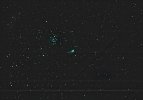 Photo by Steve Luzader
Photo by Steve Luzader
Comet NEAT photographed near the Beehive Cluster on May 14, 2004. The exposure
was about 5 minutes on Fuji Superia 800 color film using a 75 - 210 mm zoom
lens set at 135 mm f/4. The camera was riding piggyback on my 8-inch
SCT, and I was guiding on the comet. The exposure was stopped after 5 minutes
because a band of clouds moved in.
 Image by Steve Luzader
Image by Steve Luzader
Comet NEAT imaged on May 16, 2004. This is a "stack and track" composite
of six 20-second STV images taken through my 8-inch SCT at f/10 and
processed with AIP4WIN . Because of the narrow field of view, only the head
and coma are visible in the image.
 Images by Steve Luzader
Images by Steve Luzader
Comet Hoenig imaged in Ursa Major on Sept. 8, 2002 at Astronomy Weekend, Blackwater
Falls.. Clicking on the thumbnail brings up an animated GIF of six images
taken about every 20 minutes over a period of almost two hours. Each STV frame
was a two minute total exposure (track and accumulate images consisting of
either two 1-minute exposures or three 40-second exposures). Measurements
of the displacement indicate a speed of 30 km/s across the field of view.
A bright aurora was present during the first shot in the sequence.
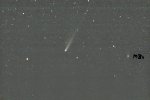 Photo by Gus Johnson
Photo by Gus Johnson
Comet Ikeya-Zhang photographed near Deep Creek Lake, MD, on April 1, 2002.
The comet was near M31 at that time. The exposure was 70 seconds with a 135mm
lens at f/2.8 on Fujicolor 800 film. Altazimuth tracking was used.
 Photo by Steve Luzader
Photo by Steve LuzaderComet Hyukatake photographed March 26, 1996 from my driveway in Frostburg. The picture was a 40 second piggyback exposure with a 135 mm lens at f/5.6 on Konica 3200 film.
 Comet Hyukatake
Comet HyukatakePhoto by Gus Johnson 3/27/96, 3:25 AM EST in rural Garrett County, MD. 45 second exposure with 50 mm lens at f/1.9 on Kodak Gold 400 film.
 Comet Hyukatake with Arcturus
Comet Hyukatake with ArcturusPhoto by Gus Johnson
Gus didn't provide any information about this picture except that the bright star to the right of the comet is Arcturus. Comparing this photo with one by S. Luzader and data from Sky & Telescope show that the picture was taken on March 23, 1996.
 Photo by Gus Johnson
Photo by Gus Johnson
Comet Hale-Bopp photographed near Deep Creek Lake in rural Garrett County, Maryland. The
picture was taken at 4:00 AM on 3/11/97. The image is a 2 minute exposure on Kodak ASA 1000
film with a 50 mm lens at f/1.9. Altazimuthal tracking was used for this relatively short
exposure.
 Photo by Steve Luzader
Photo by Steve Luzader
Comet Hale-Bopp photographed in rural southwestern Pennsylvania, near Frostburg. The picture
was taken at approximately 8 PM on 4/2/97. The image is a 1.5 minute piggyback exposure with
a 55 mm lens at f/2.8 on Fujicolor 400 film. The image seen here is cropped and rotated from
the original so that vertical is straight up in the picture. The bright star near the comet is
Almach in Andromeda, and the open cluster M34 is above and to the left of the comet.
